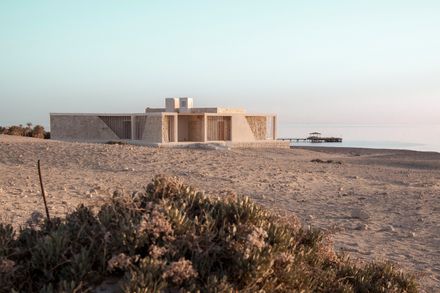Breathing Beach House
ARCHITECTS
Karm Architecture Lab (Kal)
CONSTRUCTION ENGINEERING
Mohamed Sobhy, Ahmed Adel
SITE TECHNICIANS
Ahmed Awad, Karam Abdelsalam, Badawy El Bar, Mohamed Anwar, Abdelrahman Gebely, Alaa Eid
LEAD ARCHITECT
Farah Faheem
PRINCIPAL IN CHARGE
Karim El Kafrawi
ENVIRONMENTAL REPORT
Mariam Maged
CONSTRUCTION MANAGEMENT
Mahmoud Emad, Wael Ahmed
GENERAL MANAGEMENT
Ahmed Dawood, Mostafa Ascar
LOCAL LIMESTONE CONSTRUCTION EXPERT
Mohamed Abulhassan
AERIAL PHOTOGRAPHY
Blue Camel Media
YEAR
2021
LOCATION
Marsa Alam, Egypt
CATEGORY
Houses, Sustainability
The single-story 3-bedroom family vacation home was envisioned as a truly vernacular structure, one that celebrates both the desert and the Red Sea, within its idyllic sea-front location in Egypt’s Eastern desert.
Due to the site’s climatic conditions and the structure’s exposed location, with temperatures reaching 50 Celsius in summer, the home’s design was heavily influenced by the environmental strategies that would protect it.
Inspired by the philosophies of biomimicry and biophilia, the Breathing Beach House was designed to act as a living thing, reacting to climatic conditions to create comfortable indoor environments for its inhabitants.
Built from the exact natural stone material as the ground it stands on, the home is a celebration of the ancient desert scape that was once submerged underwater.
The loading-bearing walls built from fossilized coral limestone, a material that has been weathered through millennia, was the ideal sustainable building block for the home.
No excavations were needed to extract this material as the entire structure was built by reclaiming the discarded rubble collected from excavation sites close to the project.
The mostly forgotten building block reduced the construction costs by about 40% compared to similar projects, employing only experienced local craftsmanship from around the remote area.
The thick, load-bearing 45cm and 60cm earth walls perform incredibly well, retaining heat during the day and allowing for a slow release at night, and vice versa in winter.
Additionally, the natural building blocks allow the walls to ‘breath,’ in some cases producing droplets of condensation on the indoor wall surfaces when temperatures change, performing a cooling function similar to the perspiration of human skin.
However, the greatest gifts that this natural building material offers are the preserved fossils of ancient sea life that once covered this desert, showcased as geological masterpieces, and celebrated within the home’s wall for as long as it stands.
The most predominant feature of the home is the two ventilation towers that protrude through the center of the structure like the antennas of a desert animal.
One of the towers acts as a wind catcher, absorbing cooled natural air into the home, whilst the other functions as a Solar Chimney, suctioning hot air out, both are designed to alternate functions during different hours of the day, acting, quite literally, as the lungs of the home.
Other environmental strategies include the second-skin coral limestone and bamboo walls that wrap around the home’s Southern elevations like a desert creature’s protective outer shell, shielding the home’s inner walls from the sun’s direct heat gain during the day.
The home’s location is ideal, with the back entry elevation facing the South, and the sea-facing elevation overlooking the Northern prevailing winds.
Cantilevered roof slabs and protruding walls at the North elevation’s large, glazed openings create further recesses, adding a second layer of protection from excessive heat gain in the early hours of the day.
Additionally, the floor plan was designed in a crab-like form, guaranteeing that every interior space is offered unobstructed 180 views of the Red Sea, whilst keeping the plan condensed and compacted to help create cooled indoor and outdoor spaces with multiple outdoor pockets of greenery (yet to be vegetated with indigenous plant species.)
The compressed yet porous plan layout also ensures that every main space allows for natural cross-ventilation, with strategically placed inlets and outlets for all 3 bedrooms and the main open-plan living area, enabling natural air flow to reduce the dependency on mechanical cooling.



































